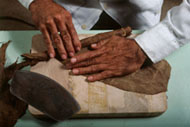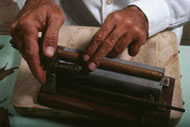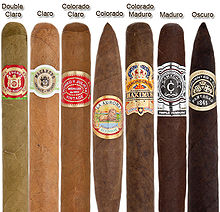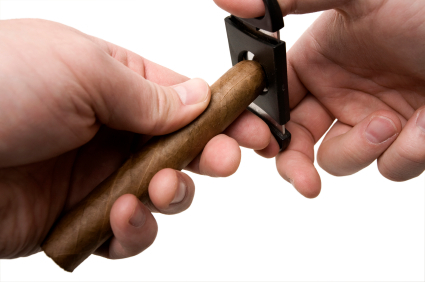
MANUFACTURING Tobacco leaves are harvested and aged using a process that combines use of heat and shade to reduce sugar and water content without causing the large leaves to rot. This first part of the process, called curing, takes between 25 and 45 days and varies substantially based upon climatic conditions as well as the construction of sheds or barns used to store harvested tobacco. The curing process is manipulated based upon the type of tobacco, and the desired color of the leaf. The second part of the process, called fermentation, is carried out under conditions designed to help the leaf die slowly. Temperature and humidity are controlled to ensure that the leaf continues to ferment, without rotting or disintegrating. This is where the flavor, burning, and aroma characteristics are primarily brought out in the leaf. Once the leaves have aged properly, they are sorted for use as filler or wrapper based upon their appearance and overall quality. During this process, the leaves are continually moistened and handled carefully to ensure each leaf is best used according to its individual qualities. The leaf will continue to be baled, inspected, unbaled, reinspected, and baled again repeatedly as it continues its aging cycle. When the leaf has matured according to the manufacturer's specifications, it will be used in the production of a cigar. Quality cigars are still hand-made. An experienced cigar-roller can produce hundreds of very good, nearly identical, cigars per day. The rollers keep the tobacco moist — especially the wrapper — and use specially designed crescent-shaped knives, called chavetas, to form the filler and wrapper leaves quickly and accurately. Once rolled, the cigars are stored in wooden forms as they dry, in which their uncapped ends are cut to a uniform size. From this stage, the cigar is a complete product that can be "laid down" and aged for decades if kept as close to 21°C (70°F), and 70% relative humidity, as the environment will allow. Once cigars have been purchased, proper storage is usually accomplished by keeping the cigars in a specialized wooden box, or humidor, where conditions can be carefully controlled for long periods of time. Even if a cigar becomes dry, it can be successfully re-humidified so long as it has not been handled carelessly and done so gradually. The loss of original tobacco oils, however, will greatly affect the taste.
Some cigars, especially premium brands, use different varieties of tobacco for the filler and the wrapper. Long filler cigars are a far higher quality of cigar, using long leaves throughout. These cigars also use a third variety of tobacco leaf, called a "binder," between the filler and the outer wrapper. This permits the makers to use more delicate and attractive leaves as a wrapper. These high-quality cigars almost always blend varieties of tobacco. Even Cuban long-filler cigars will combine tobaccos from different parts of the island to incorporate several different flavors. In low-grade and machine-made cigars, chopped tobacco leaves are used for the filler, and long leaves or a type of "paper" made from tobacco pulp is used for the wrapper which binds the cigar together. This alters the burning characteristics of the cigar, causing hand-made cigars to be sought-after. Historically, a lector or reader was always employed to entertain cigar factory workers. This practice became obsolete once audio books for portable music players became available, but it is still practiced in some Cuban factories. The name for the Montecristo cigar brand may have arisen from this practice. COMPOSITION Cigars are composed of three types of tobacco leaves, whose variations determine smoking and flavor characteristics:WrappersA cigar's outermost leaves, or wrapper, come from the widest part of the plant. The wrapper determines much of the cigar's character and flavor, and as such its color is often used to describe the cigar as a whole. Over 100 wrapper shades are identified by manufacturers, but the seven most common classifications are as follows, from lightest to darkest: Some manufacturers use an alternate designation:
In general, dark wrappers add a touch of sweetness, while light ones add a hint of dryness to the taste. It is commonly accepted that the wrapper contributes about 40 percent of the flavor, while the filler and binder contributes the other 60 percent. It is generally accepted that maduro cigars are stronger in flavor than the same cigar in a lighter wrapper, but this does not apply to all cigars. FillersThe majority of a cigar is made up of fillers, wrapped-up bunches of leaves inside the wrapper. Fillers of various strengths are usually blended to produce desired cigar flavors. In the cigar industry this is referred to as a "blend". Many cigar manufacturers pride themselves in constructing the perfect blend(s) that will give the smoker the most enjoyment. The more oils present in the tobacco leaf, the stronger (less dry) the filler. Types range from the minimally flavored Volado taken from the bottom of the plant, through the light-flavored Seco (dry) taken from the middle of the plant, to the strong Ligero from the upper leaves exposed to the most sunlight. Fatter cigars of larger gauge hold more filler, with greater potential to provide a full body and complex flavor. However, this effect can be diminished because of the generally poorer burn characteristics of thicker cigars (greater than 50 ring gauge), and the fact that these cigars burn cooler. This can prevent the full spectrum of flavors from being easily detectable. When used, Ligero is always folded into the middle of the filler because it burns slowly. Fillers can be either long or short; long filler uses whole leaves and is of a better quality, while short filler, also called "mixed", uses chopped leaves, stems, and other bits. Recently some manufacturers have created what they term "medium filler" cigars. They use larger pieces of leaf than short filler without stems, and are of better quality than short filler cigars. Short filler cigars are easy to identify when smoked since they often burn hotter and tend to release bits of leaf into the smoker's mouth. Long filled cigars of high quality should burn evenly and consistently. Also available is a filler called "sandwich" (sometimes "Cuban sandwich") which is a cigar made by rolling short leaf inside long outer leaf. If a cigar is completely constructed (filler, binder and wrapper) of tobacco from only one country, it is referred to in the cigar industry as a "puro" which in Spanish means "pure". BindersBinders are elastic leaves used to hold together the bunches of fillers. Essentially, binders are wrappers that are rejected because of holes, blemishes, discoloration, or excess veins.
SIZE AND SHAPE Cigars are commonly categorized by the size and shape of the cigar, which together are known as the vitola.The size of a cigar is measured by two dimensions: its ring gauge (its diameter in sixty-fourths of an inch) and its length (in inches). ParejoThe most common shape is the parejo, sometimes referred to as simply "coronas", which have traditionally been the benchmark against which all other cigar formats are measured. They have a cylindrical body, straight sides, one end open, and a round tobacco-leaf "cap" on the other end which must be sliced off, have a V-shaped notch made in it with a special cutter, or punched through before smoking. Parejos are designated by the following terms:
These dimensions are, at best, idealized. Actual dimensions can vary considerably. FiguradoIrregularly shaped cigars are known as figurados and are sometimes considered of higher quality because they are more difficult to make. Historically, especially during the 19th century, figurados were the most popular shapes; however, by the 1930s they had fallen out of fashion and all but disappeared. They have, however, recently received a small resurgence in popularity, and there are currently many brands (manufacturers) that produce figurados alongside the simpler parejos. The Cuban cigar brand Cuaba only has figurados in their range. Figurados include the following: Arturo Fuente, a large cigar manufacturer based in the Dominican Republic, has also manufactured figurados in exotic shapes ranging from chili peppers to baseball bats and American footballs. They are highly collectible and extremely expensive, when publicly available. In practice, the terms Torpedo and Pyramid are often used interchangeably, even among very knowledgeable cigar smokers. Min Ron Nee, the Hong Kong-based cigar expert whose work An Illustrated Encyclopaedia of Post-Revolution Havana Cigars is considered to be the definitive work on cigars and cigar terms, defines Torpedo as "cigar slang". Nee thinks the majority is right (because slang is defined by majority usage) and torpedoes are pyramids by another name. Little cigarsLittle cigars (sometimes called small cigars) differ greatly from regular cigars. They weigh less than cigars and cigarillos, but, more importantly, they resemble cigarettes in size, shape, packaging, and filters. Sales of little cigars quadrupled in the U.S. from 1971 to 1973 in response to the Public Health Cigarette Smoking Act, which banned the broadcast of cigarette advertisements and required stronger health warnings on cigarette packs. Cigars were exempt from the ban, and perhaps more importantly, were taxed at a far lower rate. Little cigars are sometimes called "cigarettes in disguise", and unsuccessful attempts have been made to reclassify them as cigarettes. Sales of little cigars reached an all-time high in 2006, fueled in great part by their taxation loophole.[15] SmokingTo smoke a cigar, a smoker cuts it, lights it, then puts the unlit end into the mouth and draws smoke into the mouth. Some smokers inhale the smoke into the lungs, particularly with little cigars, but this is uncommon otherwise. A smoker may swirl the smoke around in the mouth before exhaling it, and may exhale part of the smoke through the nose in order to smell the cigar better as well as to taste it. CuttingAlthough some cigars are cut on both ends, or twirled at both ends, the vast majority come with one straight cut end and one end in a "cap". Most quality handmade cigars, regardless of shape, will have a cap which is one or more small pieces of a wrapper pasted on to one end of the cigar with either a natural tobacco paste or with a mixture of flour and water. The cap end of a cigar must be cut off for the cigar to be smoked properly. It is the rounded end without the tobacco exposed, and this is the end one should always cut. If the cap is cut jaggedly or without care, the end of the cigar will not burn evenly and smokeable tobacco will be lost. Some cigar manufacturers purposely place different types of tobacco from one end to the other to give the cigar smokers a variety of tastes, body and strength from start to finish. Smoking a cigar from the wrong end may result in a bad experience.
LightingThe "head" of the cigar is usually the end closest to the cigar band. The opposite end of the cigar is called the "foot". The band identifies the type of the cigar and may be removed or left on. The smoker cuts the cap from the head of the cigar and ignites the foot of the cigar. The smoker draws smoke from the head of the cigar with the mouth and lips, usually not inhaling into the lungs. When lighting, the cigar should be rotated to achieve an even burn and the air should be slowly drawn with gentle puffs. Cigars can be lit with the use of butane-filled lighters. Butane is colorless, odorless and burns clean with very little, if any, flavor. It is not recommended to use fluid-filled lighters and paper matches since they can influence the taste. Another option is wooden matches. They are not treated and soaked with sulfur and thus the smoke is not affected with chemicals. [23] Cigars packaged in metal tubes will typically include a thin wrapping of cedar. This may be used to light the cigar, eliminating the problem of lighters or matches affecting the taste. HumidorsThe level of humidity in which cigars are kept greatly varies their taste. It is believed that a cigar's flavor best evolves when stored at a relative humidity of approximately 68-74% and a temperature of 64 F. An ideal rate of humidity allows an even burning of the cigar. On the contrary, dry cigars become fragile and burn faster while damp cigars burn unevenly and take on a heavy acidic flavor. Humidors together with their humidifiers are then used to serve this purpose. Humidor's interior lining is basically constructed with three types of wood which are: Spanish cedar, American (or Canadian) red cedar, and Honduran mahogany. Most humidors come with a plastic or metal case with a sponge that works as the humidifier, although most recent versions come on polymer acryl. The latter must be filled only with distilled water, and the former may use a solution of propylene glycoland distilled water as well. Humidifiers may get contaminated with bacteria and to avoid such contamination they should be replaced every two years. Humidors also come with hygrometers which are analog or digital. There are three systems of analog hygrometers: analog hygrometers with a metal spring, analog natural hair hygrometers, and analog synthetic hair hygrometers.[28]
* information extracted from Wikipedia.com |
| SANTO DOMINGO DOMINICAN REPUBLIC DON ROGER CIGARS PUROS DON ROGER TOBACCO |
SANTO DOMINGO, DOMININCAN REPUBLIC • (786) 284-7699 / (809) 683-8054 / (809) 683-8629 • INFO@PUROSDONROGER.COM
© 2010 PUROS DON ROGER • PUROSDONROGER.COM / DONROGERCIGARS.COM







